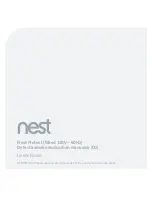
21
20
(6) In the living area(s) of a residential board and
care occupancy”
(Reprinted with permission from NFPA 72®, National Fire Alarm
& Signaling Code Copyright © 2013 National Fire Protection
Association, Quincy, MA 02269. This reprinted material is not the
complete and official position of the National Fire Protection
Association, on the referenced subject which is represented only
by the standard in its entirety.) (National Fire Alarm & Signaling
Code® and NFPA 72® are registered trademarks of the National
Fire Protection Association, Inc., Quincy, MA 02269.)
SMOKE DETECTION
Are more smoke alarms desirable?
The required number of smoke alarms might
not provide reliable early warning protection
for those areas separated by a door from
the areas protected by the required smoke
alarms. For this reason, the use of additional
smoke alarms for those areas for increased
protection is recommended. The additional
areas include the dining room, and hallways
not protected by the required smoke alarms.
The installation of smoke alarms in kitchens,
attics (finished or unfinished), or garages is
not normally recommended, because these
locations occasionally experience conditions
that can result in improper operation. As Nest
Protect is also a Carbon Monoxide alarm, it is
not recommended to install it in a furnace room
or a utility room if it contains a water heater or
a furnace. It should be 15-20 feet from these
appliances to avoid transient conditions and/or
perceived nuisance alarms.
INSTALLATION CODE
THIS EQUIPMENT SHOULD BE INSTALLED IN
ACCORDANCE WITH THE NATIONAL FIRE
PROTECTION ASSOCIATION’S STANDARD 72
(National Fire Protection Association,
Batterymarch Park, Quincy, MA 02269).
NOTE
Specific requirements for Smoke Alarm
installation vary from state to state and from
region to region. Check with your local Fire
Department for current requirements in your area.
WARNING
This product is intended for use in ordinary
indoor locations of family living units. It
is not designed to measure compliance
with Occupational Safety and Health
Administration (OSHA) commercial or
industrial standards.
WHERE TO INSTALL YOUR SMOKE ALARMS
For your information, the National Fire Alarm
and Signaling Code, NFPA 72, reads as follows:
Æ(/$+$' H[gk_h[Z:[j[Yj_ed$Ç
Æ M^[h[h[gk_h[ZXoWffb_YWXb[bWmi"YeZ[i"
or standards for a specific type of occupancy,
approved single- and multiple-station smoke
alarms shall be installed as follows:
' ?dWbbib[[f_d]heeciWdZ]k[ijheeci
( Ekji_Z[e\[WY^i[fWhWj[Zm[bb_d]kd_jib[[f_d]
area, within 6.4 m (21 ft) of any door to a sleeping
room, the distance measured along a path of travel
(3) On every level of a dwelling unit,
including basements
(4) On every level of a residential board and care
occupancy (small facility), including basements
and excluding crawl spaces and unfinished attics
+ ?dj^[b_l_d]Wh[Wie\W]k[ijik_j[
J^_iicea[WbWhc_idej_dj[dZ[ZjeWb[hj
hearing impaired residents. Alarms specifically
designed for the hearing impaired, which
\[Wjkh[Z[l_Y[ib_a[ÓWi^_d]ijheX[b_]^jieh
low frequency devices are available to alert the
hearing impaired in case of fire.
J^_iicea[WbWhcWbed[_idejWik_jWXb[
substitute for complete fire detection
systems in places housing many people—like
apartment buildings, condominiums, hotels,
motels, dormitories, hospitals, long-term
health care facilities, nursing homes, day care
facilities, or group homes of any kind—even if
they were once single-family homes. It is not a
suitable substitute for complete fire detection
systems in warehouses, industrial facilities,
commercial buildings, and special-purpose
non-residential buildings which require special
fire detection and alarm systems. Depending
on the building codes in your area, this smoke
alarm may be used to provide additional
protection in these facilities.
LIMITATIONS OF CARBON MONOXIDE (CO) ALARMS
D;L;H_]deh[oekhYWhXedceden_Z[WbWhc_\_j
WbWhci$H[\[hjeÆM^WjjeZe_dYWi[e\WYWhXed
monoxide alarm” for more information. Failure
to do so can result in injury or death.
J^_i9EWbWhc_iZ[i_]d[Z\ehki[_di_Z[W
single-family home or apartment. It is not
meant to be used in common lobbies, hallways,
or basements of multi-family buildings unless
working CO alarms are also installed in each
family living unit. CO alarms in common areas
may not be heard from inside individual family
living units.
J^_i9EWbWhcWbed[_idejWik_jWXb[ikXij_jkj[
for complete detection systems in places
which house many people, like hotels or
dormitories, unless a CO alarm is also placed in
each unit.
:EDEJki[j^_i9EWbWhc_dmWh[^eki[i"
industrial or commercial buildings, special-
purpose non-residential buildings, or airplanes.
This CO alarm is specifically designed for
residential use, and may not provide adequate
protection in non-residential applications.
Iec[_dZ_l_ZkWbiWh[ceh[i[di_j_l[je9E
than others, including people with cardiac or
respiratory problems, infants, unborn babies,
pregnant mothers, or elderly people can be
more quickly and severely affected by CO.
Members of sensitive populations should
consult their doctors for advice on taking
additional precautions.
J^[i_b[dY[\[Wjkh[_i\ehoekhYedl[d_[dY[
only and will not correct a CO problem. Always
check your home for a potential problem after
any alarm. Failure to do so can result in injury
or death.
Page: 21
Page: 20















